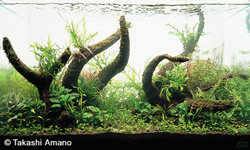
May 31st, 2005 (7th day)
A week from planting. Although half of the tank water was changed daily, the water still looked somewhat cloudy. The growth of stem plants was still sparse.
Stem plants come in various shapes of leaves and colors, and they can be enjoyed in a variety of combinations. Stem plants are used in this layout taking their individual characteristics into consideration and avoiding placing the same leaf shapes and colors side-by-side.
Trimming is an essential part of a layout with stem plants. The stem plants were trimmed three times before this aquascape was completed, keeping in mind the balance with fast-growing Glossostigma and Riccia. The stem plants, which were somewhat sparse initially, increased their volumes with repeated trimming and rendered denseness to the entire aquascape. Their leaves became smaller and provided a sense of depth.
If you glance at changes in a layout over a period of time, you will notice that aquatic plants are growing steadily although you hardly notice it ordinarily. Stem plants particularly grow fast as compared to ferns and mosses. The aquascape reached its completion approximately two and a half months after planting, when the volumes of stem plants and the undergrowth balanced out.

A week from planting. Although half of the tank water was changed daily, the water still looked somewhat cloudy. The growth of stem plants was still sparse.
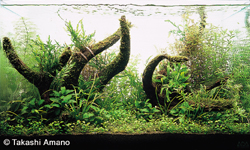
15 days has passed since planting. The water has become clear. Glossostigma and Echinodorus tenellus have developed runners and Willow Moss on driftwood is growing steadily.
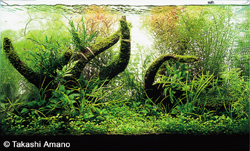
The first trimming on the 22nd day from planting. The stem plants planted at the same time to the same height were beginning to show a difference in their growth depending on their types. Trimming became necessary to keep their growth in balance.
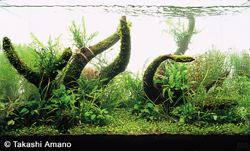
Stem plants on the left and right sides are trimmed as if following a flowing line. The low growing Echinodorus tenellus, Glossostigma and Riccia are trimmed as well.
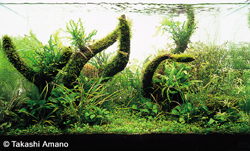
A week has passed since the first trimming. Stem plants are already developing new shoots. Bolbitis and Microsorum are also growing, albeit very little.
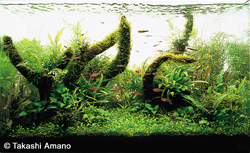
Five different types of fish: Neon Tetra, Scarlet Gem, Aplocheilichthys macrophthalmus, Red Phantom Tetra, and Inpaichthys kerri, are added taking the aquascape and the swimming space into consideration.
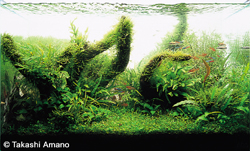
Stem plants are growing densely and Cryptocoryne is beginning to develop its submersed leaves. Wood Tight used for attaching plants such as Bolbitis is removed after confirming that plants have grown attached.
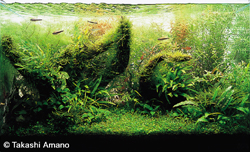
Approximately one month has passed since the first trimming. The stem plants are almost reaching the water surface. Another trimming is necessary to shape the stem plant bushes. The low growing plants are not trimmed.
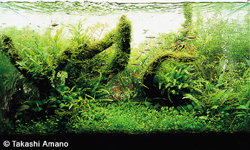
The stem plants are trimmed along the driftwood at the location somewhat higher than the first trimming. Old Bolbitis leaves and the leaves with algae growing on them are cut off as well.
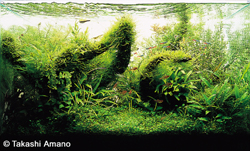
Approximately one week after the 2nd trimming. New shoots are developing well and the leaves are getting smaller than the size at the initial planting time with repeated trimming.
Other advantages of stem plants are that they are sturdy, easy to grow, and fast growing. However, these are also the shortcomings of stem plants as well. As we delight in their growth, they soon reach the water surface and fill up the empty spaces. To maintain an aquascape just like the image we have in mind, frequent trimming becomes necessary. With repeated trimming, stem plant bushes become beautiful and the aquascape appears more finished.
Aquarium: W60 x D30 x H36 (cm)
Lighting: NA Lamp 20W x 4 (Green Glow/604), turned on 10 hours per day
Filter: Super Jet Filter ES-600 (Bio Rio, NA Carbon)
Substrate: Aqua Soil, Bright Sand, Power Sand Special S, Bacter 100, Clear Super, Tourmaline BC, Penac W/for Aquarium, Penac P
CO2: Pollen Glass Beetle, 3 bubbles per second (CO2 System 74, Tropical Forest)
Aeration: 14 hours after the light is turned off using Lily Pipe P-2
Additives: Brighty K; Green Brighty STEP2; Green Gain after trimming
Water change: 1/3 once a week
Water quality: Temperature: 26°C; pH: 6.8; TH: 20 mg/l, NO2: < 0.02 mg/l; NO3: < 1mg/l; COD: 4mg/l